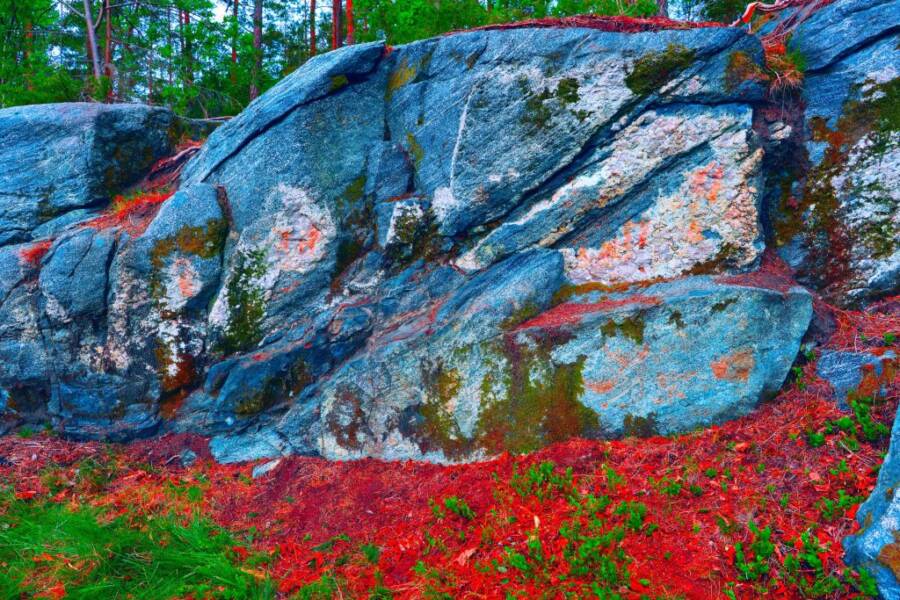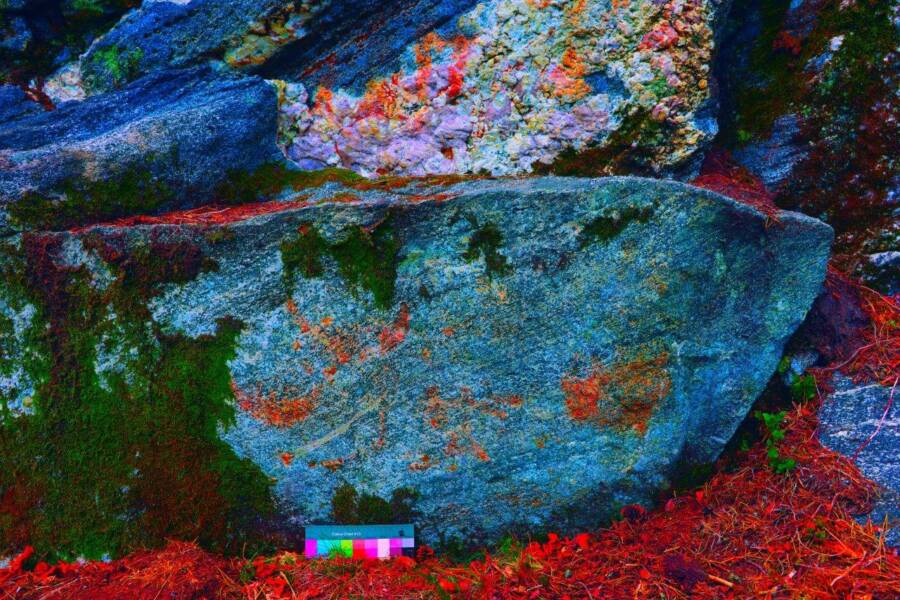Dating back several millennia, these stunning petroglyphs uncovered south of Oslo appear to depict hunting scenes as well as oarsmen rowing in a boat.

Jan Magne Gjerde/NIKUDiscovered south of Oslo, these ancient rock paintings appear to depict hunters and rowers.
Tormod Fjeld of Norway was recently hiking with his family near Oslo when he noticed a curious rock. But Fjeld was not just a hiker, and this rock was not just a rock. As an amateur archaeologist and petroglyph enthusiast, Fjeld was able to determine that the rock face was covered in Bronze Age paintings.
“We were enjoying a little snack of juice and biscuits on a Sunday when I saw something red on the rock,” said Fjeld, who has uncovered hundreds of petroglyphs with his friends in recent years, according to the Norwegian Institute for Cultural Heritage Research (NIKU).
As Artnet reports, Fjeld used an app on his phone to determine if the pigments on the rock were natural or manmade. When the image loaded on his screen, Fjeld was delighted to discover that the rock face contained a number of renderings, including people rowing, animals, and other human figures.

“I took a picture and went into the app,” Fjeld told NIKU. “I had something like an out-of-body experience. I didn’t really think it could be anything.”
He then called Jone Kile-Vesik, a local archaeologist, who alerted NIKU.
“We engaged NIKU precisely to establish the authenticity of this find,” Kile-Vesik said. “As this is the first of its kind here, this is a narrow field where we lack exactly this type of cutting-edge expertise. This is a very rare find.”

Jan Magne Gjerde/NIKUThe location of the rock face has been concealed to protect the paintings, which are very delicate.
NIKU examined the rock face, and confirmed what Fjeld’s app had suggested. The images were not “randomly formed” by natural pigments like iron deposits but appeared to have been purposefully placed there by ancient people. “[H]ere there are so many ‘coincidences’ gathered together that it is just not random,” Jan Magne Gjerde of NIKU explained.
So how did something like this stay hidden for so long? Experts think that the faded pigments were almost impossible to make out, effectively hiding them from the naked eye for thousands of years. At one point, however, the entire rock face may have been covered in paintings, and only those protected by the rock’s overhang survived.
“They are extremely hard to find due to the faintness of the paint,” Gjerde told Artnet. “Not many people have been looking for them, which is why not many have been found, though we are sure there are more paintings.”
Indeed, the pigments are so rare and so delicate that NIKU has decided to keep the location of this newly-discovered rock face a secret from the public for now.
“Precisely the rarity and the fact that it is so fragile, means that we are reluctant to say where in Østfold this is, except to say that it is in Moss municipality,” Kile-Vesik said. “[E]ven the touch of the uninitiated can be enough to remove the pigments. Should you still discover it, we ask you to admire it from a distance, and not touch it.”

Jan Magne Gjerde/NIKUThough the pigments have faded over time, experts suspect that the entire rock face was once covered with ancient art.
For Fjeld, this rock face is just one of many incredible discoveries that he and his friends have made. According to The New York Times, he and two others have been hunting for petroglyphs since 2016. Usually, the discoveries are more hard-won than the Bronze Age art that Fjeld happened to spot while hiking, as these petroglyphs’ ancient pigments are easiest to spot only when the Sun is rising or setting.
“This is not an eight to four job,” Magnus Tangen, one of Fjeld’s petroglyph hunting friends told The New York Times. “It has to be a passion.”
“Yes, our families think we are crazy,” Fjeld added. After nights of searching for petroglyphs, he and the others sometimes don’t return home until two or three in the morning.
But as his latest find has proven, incredible discoveries are sometimes hidden in plain sight — as long as you know where to look.
After reading about the Bronze Age rock paintings found in Norway, learn about the 56-foot Viking ship that was discovered beneath a Norwegian farm. Then, read about how Australian vandals destroyed the 30,000-year-old art at Koonalda Cave.





